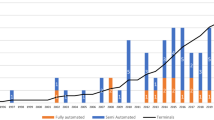Abstract
Containers arriving at a port-of-entry are inspected using sensors and devices to detect drugs, weapons, nuclear materials and other illegal cargo. Measurement errors associated with the inspection process may result in higher misclassification of containers. In this paper, we propose and formulate three inspection policies for containers at port-of-entry assuming the presence of sensor measurement errors. The optimization of the policies is carried out and the performance of each in terms of misclassification probabilities is compared. In each of the policies, the optimum settings are determined by minimizing the probability of false rejection while limiting the probability of false acceptance to a specified tolerance level. The results show that repeat inspections improve performance in terms of correct container classification. Expressions are presented for container misclassification in a single station, as well as in systems with several inspection stations arranged in different configurations such as series, parallel, series-parallel and parallel-series.
Similar content being viewed by others
References
Boros, E., Fedzhora, L., Kantor, P. B., Saeger, K., & Stroud, P. (2009). A large-scale linear programming model for finding optimal container inspection strategies. Naval Research Logistics, 56(5), 404–420.
Brandenstein, A. E. (2007). Article number 4373477. In Proceedings of international Carnahan conference on security technology 2007 (pp. 109–116).
Chandra, J., & Schall, S. (1988). The use of repeated measurements to reduce the effects of measurement errors. IIE Transactions, 20(1), 83–87.
Chen, S.-L., & Chung, K.-J. (1996). Selection of the optimal precision level and target value for a production process: the lower-specification limit case. IIE Transactions, 28, 979–958.
Dahlman, O., Mackby, J., Sitt, B., Poucet, A., Meerburg, A., Massinon, B., Ifft, E., Asada, M., & Alewine, R. (2005). Container security: a proposal for a comprehensive code of conduct. Defense & technology papers published by the National Defense University Center for Technology and National Security Policy, Fort Lesley J. McNair, Washington, DC. Available: http://www.ndu.edu/ctnsp/publications.html.
Deaver, D. (1995). Using guardbands to justify TURs less than 4:1. In Proceeding of ASQC 49th annual quality congress (pp. 136–141).
Dye, D. H. (2003). Sensors for screening and surveillance. Paper presented at the Hoover institute national security forum conference on technology for preventing terrorism, CA.
Eagle, A. R. (1954). A method for handling errors in testing and measuring. Industrial Quality Control, 10, 10–15.
Elsayed, E. A., Young, C. M., Xie, M., Zhang, H., & Zhu, Y. (2009). Port-of-entry inspection: sensor deployment policy optimization. IEEE Transactions on Automation Science and Engineering, 6, 265–276.
Grubbs, F. A., & Coon, H. J. (1954). On setting test limits relative to specification limits. Industrial Quality Control, 10, 15–20.
Hutchinson, B. (1991). Setting guardband test limits to satisfy MIL-STD-45662A requirements. In Proceeding of 1991 NCSL workshop and symposium (pp. 305–309).
Kim, Y. J., Cho, B. R., & Kim, N. (2007). Economic design of inspection procedures using guard band when measurement errors are present. Applied Mathematical Modeling, 31, 805–816.
Koch, D. B. (2007). PortSim-A port security simulation and visualization tool. In Security technology 2007 41st annual IEEE international Carnahan conference on 8–11 October 2007 (pp. 109–116).
Mader, D. P., Prins, J. & Lampe, R. E. (1999). The economic impact of measurement error. Quality Engineering, 11, 563–574.
McCarville, D. R. & Montgomery, D. C. (1996). Optimal guard bands for gauges in series. Quality Technology, 9, 167–177.
Ramirez-Marquez, J. E. (2008). Port-of-entry safety via the reliability optimization of container inspection strategy through an evolutionary approach. Reliability Engineering and System Safety, 93, 1698–1709.
Stroud, P. D., & Saeger, K. J. (2003). Enumeration of increasing Boolean expressions and alternative digraph implementations for diagnostic applications. In H. Chu, J. Ferrer, T. Nguyen, & Y. Yu (Eds.), Proceedings volume IV, computer, communication and control technologies: I (pp. 328–333).
Tang, K. & Schneider, H. (1988). Selection of the optimal inspection precision level for a complete inspection plan. Journal of Quality Technology, 20, 153–156.
U.S. Customs and Border Protection (USCBP) (2006). Container Security Initiative: 2006–2011 Strategic Plan. CBP Publication # 0000-0703. Washington, DC.
Wein, L. M., Wilkins, A. H., Baveja, M., & Flynn, S. E. (2006). Preventing the importation of illicit nuclear materials in shipping containers. Risk Analysis, 26(5), 1377–1393.
Author information
Authors and Affiliations
Corresponding author
Additional information
This research is conducted with partial support from ONR grant numbers N00014-05-1-0237, N00014-07-1-029, NSF grant numbers SES-05-18543, SES-08-51521, DMS-09-15139 and NSA grant number H98230-08-1-0104.
Rights and permissions
About this article
Cite this article
Zhu, Y., Li, M., Young, C.M. et al. Impact of measurement error on container inspection policies at port-of-entry. Ann Oper Res 187, 23–43 (2011). https://doi.org/10.1007/s10479-010-0681-6
Published:
Issue Date:
DOI: https://doi.org/10.1007/s10479-010-0681-6




